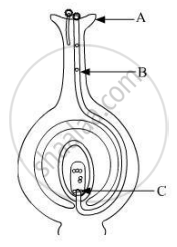Advertisements
Advertisements
प्रश्न
Distinguish between self-pollination and cross-pollination.
उत्तर
In self-pollination, only one or two flowers borne on the same plant are involved, whereas in cross-pollination two flowers borne on two plants of same species are involved.
APPEARS IN
संबंधित प्रश्न
Name the parts A, B and C shown in the diagram and write their functions.

A student identified the various parts of an embryo of a gram seed and listed them as given below :
(I) Testa
(II) Plumule
(III) Radicle
(IV) Cotyledon
(V) Tegmen
Out of these the actual parts of the embryo are :
(A) I, II, III
(B) II, III, IV
(C) III, IV, V
(D) II, IV, V
Give one example of a unisexual flower.
How is the process of pollination different from fertilization?
Name the swollen lower part of the carpel.
Where is the female gamete formed in flowering plants?
Fill in the following blank with suitable word :
The ovary of a flower becomes ....... after fertilisation.
Fill in the following blank with suitable word :
The male organ of reproduction in the flower is the.......... .
Explain the terms 'cross-pollination'?
What is seed? What are the parts of a seed? Explain with the help of a labelled diagram.
In tobacco plant, the male gametes have 24 chromosomes.
What is the number of chromosomes in the zygote?
What changes take place in the flower after fertilisation which lead to the formation of seeds and fruit?
Which among the following statements are true for unisexual flowers?
(i) They possess both stamen and pistil
(ii) They possess either stamen or pistil
(iii) They exhibit cross pollination
(iv) Unisexual flower possessing only stamens cannot produce fruits
(a) (i) and (iv)
(b) (ii), (iii) and (iv)
(c) (ii) and (iii)
(d) (i), (iii) and (iv)
The correct sequence of reproductive stages occurring in flowering plants is ______
The flask-shaped organ A at the centre of a flower is surrounded by a number of little stalks B having swollen tops which lie just inside the ring of petals.
(a) Name A. What are the various parts of A?
(b) Which part of A contains gametes?
(c) Name B. What is the swollen top of B known as?
(d) What does the swollen top of b contain?
(e) Out of A and B, which one is (i) male part, and (ii) female part of the flower?
In a bisexual flower, inspite of the young stamens being removed artificially, the flower produces fruit. Explain.
In what ways is fertilisation in a plant similar to fertilisation in a human?
In what ways is fertilisation in a plant different from fertilisation in a human?
Multiple choice question. Tick (✓) the correct choice:
The male gamete is present inside the which germinates.
- the style
- the stigma
- the anther
- the ovary
Mention the function of Flower.
Mention the function of Anther.
What are the male and female gametes in a flowering plant?
A student is asked to study the different parts of an embryo of pea seeds. Given below are the essential steps for the experiment :
(I) Soak the pea seeds in plain water and keep them overnight.
(II) Cut open the soaked seed and observe its different parts.
(III) Take some pea seeds in a petri dish.
(IV) Drain the excess water. Cover the seeds with a wet cotton cloth and leave them as it is for a day.
The correct sequence of these steps is
(A) III, I, IV, II
(B) III, IV, I, II
(C) III, I, II, IV
(D) III, II, I, IV
Draw a diagram of the longitudinal section of a flower and label on it sepal, petal, ovary and stigma.
What is phototropism?
Identify the odd. Stigma, Style, Pollen, Ovary.
Explain sexual reproduction in plants.
Pollen grains are formed by _________ division in locules of anthers.
The male reproductive part of a flower is ______.
The essential parts of a flower are ______.
In which part of the flower germination of pollen grains takes place?
The ovule of an angiosperm is technically equivalent to ______
Is the chromosome number of zygote, embryonal cells and adult of a particular organism always constant? How is the constancy maintained in these three stages?
State the number of sets of chromosomes present in a zygote.
Double fertilization is essential for formation of ______.
In flowering plants, the pollen grains are transferred to stigma by pollination but the female germ cells are present in the ovary.
Explain with the help of a labelled diagram (only concerned parts), how the male germ cell reaches the ovary.
Explain the post fertilization changes that occur in the ovary of a flower.
